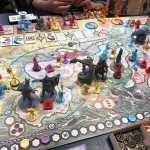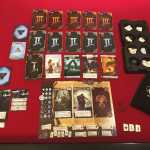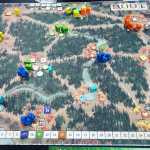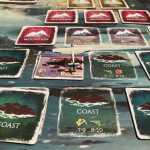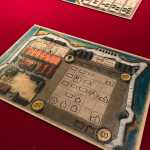Epic Review: Root

Ahhh, cute furry animals. Who doesn't love cute, furry animals? Also, who doesn't like massive woodland forest battles? And asymmetric gameplay? And really, really great meeples? Ahhh.
Root is an asymmetric, strategic wargame where you control one of 4 factions (or 6 with the must-have Riverfolk Expansion), each having its own ruleset and strategy. Do not relate this too closely with it's predecessor, Vast: Crystal Caverns, another asymmetric game which fell under its own weight of loosely connected priorities and actions. Root is tight, nuanced, and fiercely competitive - especially as players become familiar with each faction, games will get increasingly close and exciting.

especially in higher player counts
The theme is excellent, too - instead of your normal military troops or ships, Root goes full Animal Planet on us, putting the factions as various compilations of cute, cuddly animals (animeeples? meepinals?). More on them later. You're essentially competing to see who gets to control the forest. Sort of. See, each faction not only has its own rules, but its own motivations, which add to the theme, as each play style fits neatly into the theme of each character.
Unlike Vast, each faction still does a bunch of common things together: moving, attacking, building, crafting, recruiting - these are all for the most part done similarly per faction. Even the turn phases (Birdsong, Daylight, and Evening) for each faction are mostly similar. This breeds a familiarity with the core mechanics of the game, keeping play fast, while still allowing the depth and nuance of each faction to keep you coming back to the game to just try to win with those damn lizards one. more. time. It also helps with attention spans: in Vast, it was easy to check out during other turns, as there was just an overwhelming amount of difference; in Root, you can generally keep track of what each player is doing, and how it will affect you directly.
Combat is brazenly simple - the attacker rolls two 0-3 die, and deals hits based on the highest die roll of the two, with a max of how many units they're attacking with. The defender deals hits according to the lower number. The simplicity is actually quite nice - there's only a few surprises that can happen, so even though the board gets crowded and crazy at higher player counts, you generally feel like you can try a plan and execute it, without having to worry about huge RNG on dice rolls crippling you. Though, they definitely still can - a poor 0-0 roll will make even the most seasoned Root player cry. Movement allows you to move either from or to a place you rule, where rule is majority of pieces.

game, yet elegantly simple
Each spot - called "clearing" - on the board represents a population center, and has a limited number of building spaces. Furthermore, they have types (Mouse/Bunny/Fox) that determine card and action play in that space. Cards similarly have types, including a wildcard-style blue "Bird" card - thematically appropriate as the birds live in the trees above the forest, so they have no specific clearings.
Those cards you can craft, depending on how many crafting spots you have. Crafting grants you either points and items (more on items later, when we talk about the trash panda. Yes, I said trash panda.) or permanent effects throughout the game. Winning is fairly straightforward - you'll vie to get 30 points before anyone else, unless someone plays a nasty Dominance card which then becomes their victory condition, which involves getting - and holding - multiple spots on the board before it becomes their turn again. In other words, putting a target on their back and hoping people miss.
But the true beauty of this game is in the factions. Lets dive into those.
Marquise de Cat
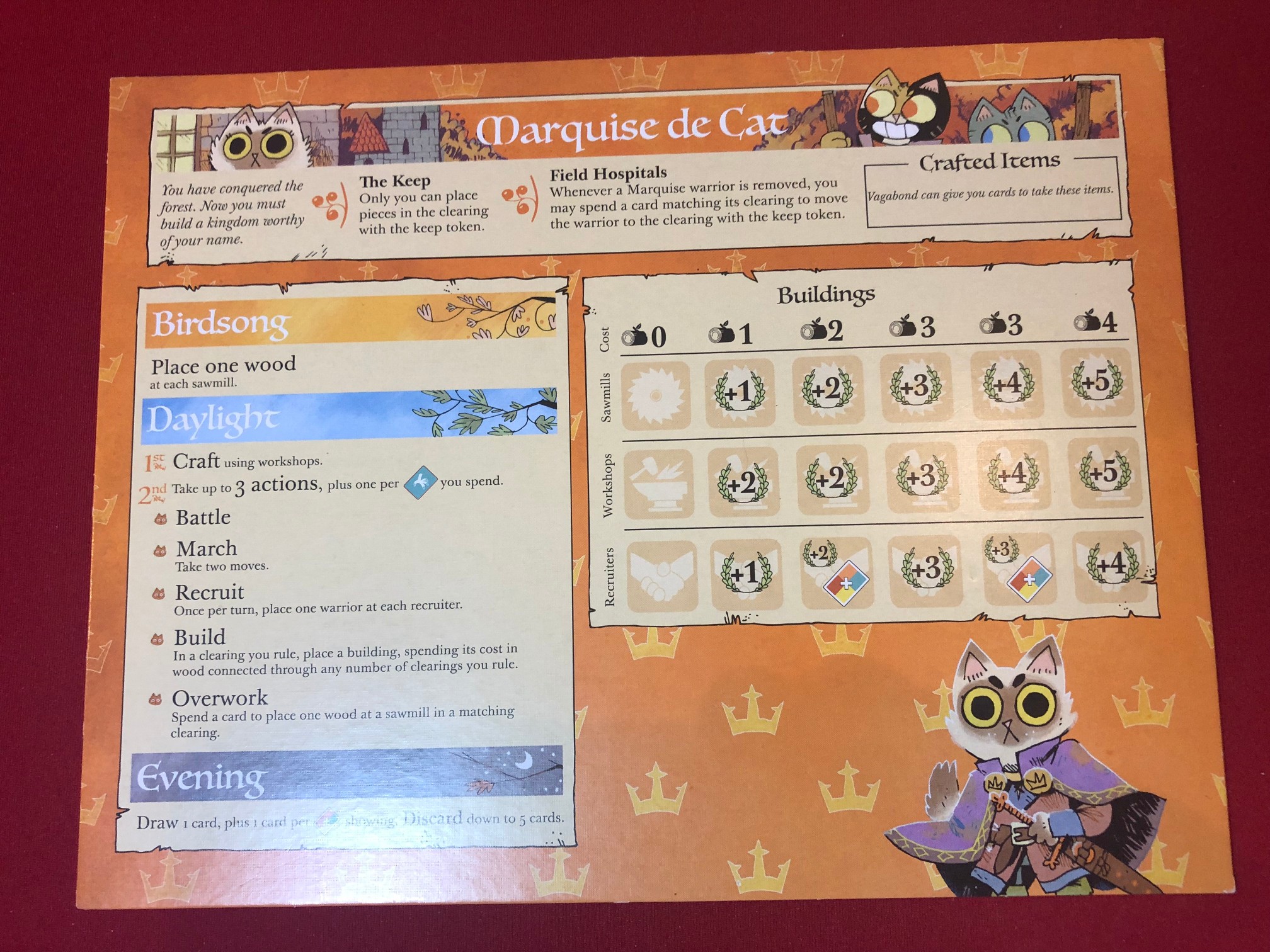
illustrated. And those cat eyes...
Ahh, the Galactic Empi...I mean the Marquise de Cat. An industrious feline bourgeoisie empire, they desire to raze the forest to build their kingdom. They usurped the rule of the forest from the Eyrie Dynasties, a fowl group of entitled former rulers that desire to reclaim their former glory. We'll get to the birds later. The cats are here to dominate, both militarily and economically. They make most of their points not through battle - surprisingly enough given their starting meeple count - but through building an economic engine. Like most empires, the cats have learned that the true sword is the coin. By controlling their supply and digging in, the Marquise under a skilled play can come to simply out-class the rest of the factions, if they play their diplomacy right.
The cats start out with a single piece on nearly every space on the board, which sounds great, until you realize just how thin you are spread. Quickly you'll learn that battle is less about you winning as much as you consolidating and defending as much as possible to guard your supply lines, as those are the bread and butter of your engine And since you're spread out, you will become defensive very, very quickly.

The Marquise have three types of buildings: sawmills, which produce a wood at the start of every turn; anvils, which allow you to craft items; and recruiters, which allow you to place a cat in each space you have a recruiter in when you Recruit. These buildings cost wood to build, increasingly so as you build more of them, but generate you a commensurate number of points. You also have to be able to connect that generated wood to the places you want to build through places you rule, so supply chain control becomes a real thing. Interestingly enough, you don't get points for having buildings on the board so much as building them - like any good war-driven empire, it's not so much about winning as it is about building tanks.
You'll get three main actions on your turn (or more if you spend "Bird" - blue - cards), so you'll be mostly limited on what you can do per turn, but order your actions and position yourself right and you'll find those three are plenty. A well-placed recruit, move, and attack can decimate a foe's plans.
The Marquise, unlike some of the other factions, don't score points in bursts. Thematically, their victory only comes in developing their economic engine and getting it humming, and unstable economies in good or bad directions are typically not sustainable ones. Playing them feels like your hard-earned usurpation is being distressed by all these entitled lower classes trying to steal your hard-earned success, and digging your sharpened claws into the ground to hold your position against the rebelling hordes. Build your engine! Keep the people oppressed, and you win. Let them rise up, or expose a hole in your furry wall, and your demise is near.
Eyrie Dynasties
Oh, the squabbling birds. Imagine a bunch of privileged old hens sitting on their nests, only to be ambushed by their arch-enemy, the cats, and relegated to a small corner of the forest. This is how the birds start, consolidated in one spot, but if anyone has watched Hitchcock's film, they'll know that you don't mess with a bunch of pissed-off birds.

bloodthirsty ones.
Probably the most straightforward to play - but not necessarily the simplest! - the birds have a "decree" of actions at the top of their board they must perform every turn for each card there, and you place 1-2 per turn. Recruit, move, battle, and build: as the Eyrie you must take each action in a clearing of that type for each card in each action type. Simple, right? You eventually get tons of actions! The world is your birdhouse! You are the grand pecker! Well, sort of, until you realize you made a huge mistake playing a red fox card in the Build column, and now you have to figure out a way to get across the map to the only remaining Fox spot that you can realistically build in, and there's no way in hell you're doing that, and...you collapse into turmoil.
Turmoil is the balancing mechanic for what can become a frighteningly powerful collection of mad plumes. At their peak, the Eyrie can be executing around 10-12 actions a turn, which makes them a huge force to be reckoned with, and countering them boils down to not hitting them head-on, but strategically attacking them in places that cause them to collapse. The Eyrie will collapse immediately if they are unable to take any of the actions in their decree, and it's punishing for them: they lose their leader (which gives them benefits), discard the decree, and lose VP according to how many birds were in that decree. Oh, and then their turn basically ends.
Even the best Eyrie player will have this happen at least once in a game. Most will have it happen twice. As the birds, your job is to ruthlessly optimize your turn so that you keep your fragile government alive as long as possible, which makes you simply a chaotic aggressor on the board. Can I mention now that makes you one of the most fun factions on the board? The Eyrie effectively prevent turtling, as the birds cut like butter through nearly any defenses. They also break ties when calculating rule, which has huge implications for movement and building. At the end of their turn, the Eyrie score for each roost (their building) on the board. More roosts, more points.
The Eyrie are, simply, exceedingly fun to play. You'll be recruiting an insane amount of troops, and on the offensive most of the game. Good area control games make attacking fun, and Root succeeds in making the birds a joy to use when carving a path through the woodlands. A skilled Eyrie player will strategically attack objectives, pinballing across the map, and using their firepower to crush all that get in their way. Like I said, a joy to play.
The Woodland Alliance
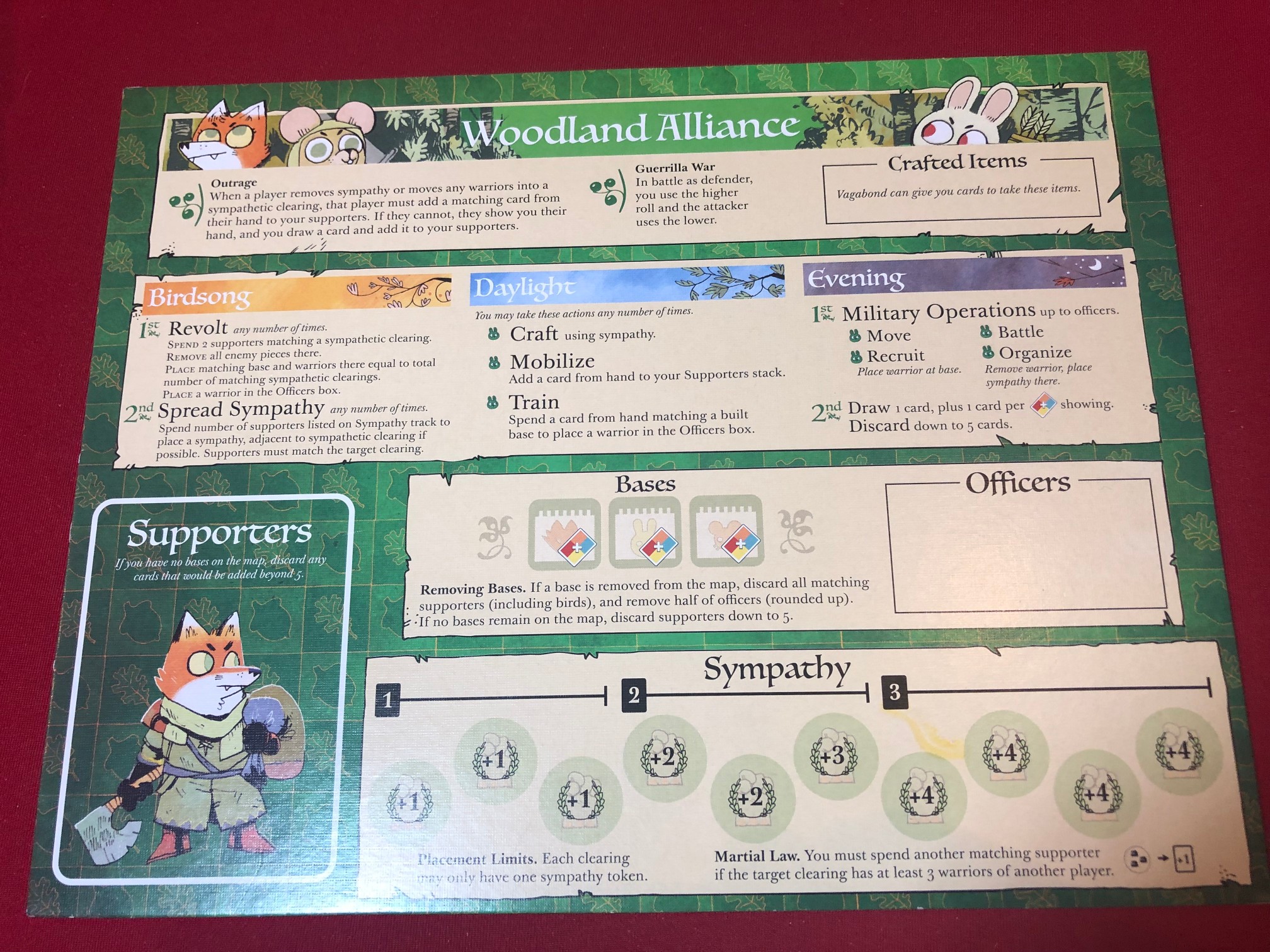
Han Solo as a rebel, axe-wielding fox?
You'll immediately notice during setup that the Alliance don't start with a piece on the board. Remember how I said there were fox, mouse, and bunny clearings? Ergo, the Woodland Alliance's recruitment base. This faction spreads sympathy, revolts, and takes control. These proletariat are tired of being stomped on and oppressed, and are forming their own rebellion to shed themselves of their unjust rulers. Rebels, they are.
You'll spend most of your time collecting cards into a supporter deck, which will allow you to use pairs of types of cards to spread sympathy in clearings. You'll discard supporters of an increasing number of the type of clearing you want to spread to, and place a sympathy token. Think of it like people getting grumbly. And, in near perfect story, as enemies move in - or try to remove your sympathy - they will have to give you cards for your supporter deck. Martyrs make great recruiters.
You can also move cards from your hand into your supporters. Get two supporters of a clearing type, and you can revolt. Arise! This revolt is the equivalent of a nuke - irrevocably destroying every enemy piece, placing one of your three bases there, and giving you a meeple and an officer. Expect the whole table to get really, really nervous about you in heavily populated clearings, and expect the inevitable groans from the table when you gain a gazillion points by flattening the space.
Officers give you Evening actions to take, such as moving, recruiting, battling, and spreading more sympathy. They are the bread and butter of your army; you spend a lot of your mid-to-late game using these guys to expand and gain control. Don't be fooled, though - you're not looking to build an army. You're looking to spread sympathy as much as possible, as that is the main way that you generate points.

dice feel to roll? So nice.
Did I mention how hard it is to trample the Alliance? Remember that whole "attacker picks the highest roll" when battling? The Alliance put a big "nope" on that and pick the higher number, regardless. So expect to take lots of casualties if you let them get a big enough army to do some damage. Which, honestly, if you're at that point, they've likely already won. Remove one of their bases, though, and you can cripple them - they lose all matching type supporters, and half their officers. Crushed!
In a crowded map, the Alliance are hidden powerhouses. The sympathy tokens make movement costly, but seem innocuous enough. It's not until you realize they can lay down a ton of points in a single turn by using some supporters from their massive deck they've accumulated to put some sympathy out, getting points; nuking a cluttered spot, and then laying a base only to place more sympathy down and get even more points. It's sick.
That said, I love playing the Alliance because of their seemingly weak position. You spend most of the game behind and on the ropes, until you're not. And I mean really not. You can also use your bases as deterrence against aggression toward you. "Mess with me and I'll nuke your favorite spot on the board. How you like them apples, eh cat?"
The Vagabond

craftsmanship.
Okay, go with me here. What if you made a war game, got some great, balanced factions, and then decided you were missing something. And you thought, "Oh! I know what it is. I need Skyrim, in board game form. As a character."
You'd have the Vagabond, our nordic raccoon.
Sort of similar to the Thief in Vast, the Vagabond plays his own game. Gallivanting around collecting items, doing quests, and poking people is his modus operandi. He operates in the game, but not of it, so to speak - rule has no effect on his movement, and he can even slip in and out the forests in the map - yes, the places between spaces.
The vagabond doesn't really use actions, so much as exhausts his items that he has. In a sense, he's more hand management than the other classes. He can hold items in his satchel, grow his ability to hold more, draw cards, or refresh items, and generally get more powerful as the game goes on. He can also give cards in his hands to other players by trading them to other players for items they've crafted, which forms alliances that gain him more points.
He also gets points by completing quests, which is essentially exhausting certain combinations of items in certain type clearings. Get enough of these of a certain type and he'll be making lots of points easily.
Furthermore, if he gets hit in battle, he can't die. He just damages items, which means they now can't be used and take up space in his satchel. Damage enough and he'll go scurrying back into the woods for a turn. But beware - the Vagabond can sneak behind your front lines and wreak some real havoc if you piss him off.
At some level, this makes the vagabond the mediator of the game. Helping him can get you lots of good cards, and getting on his bad side can make him an annoying pest in your backside. He can easily snatch victory away from players if left unattended - many a game has been lost with the rest of the table all focused on the armies on the board, only to miss the little trash panda scoring a ton of points at endgame to sneak away with the victory. To compete with the vagabond is more to manage them; to keep them weak enough that they are both an aid and not a threat.
The Lizard Cult
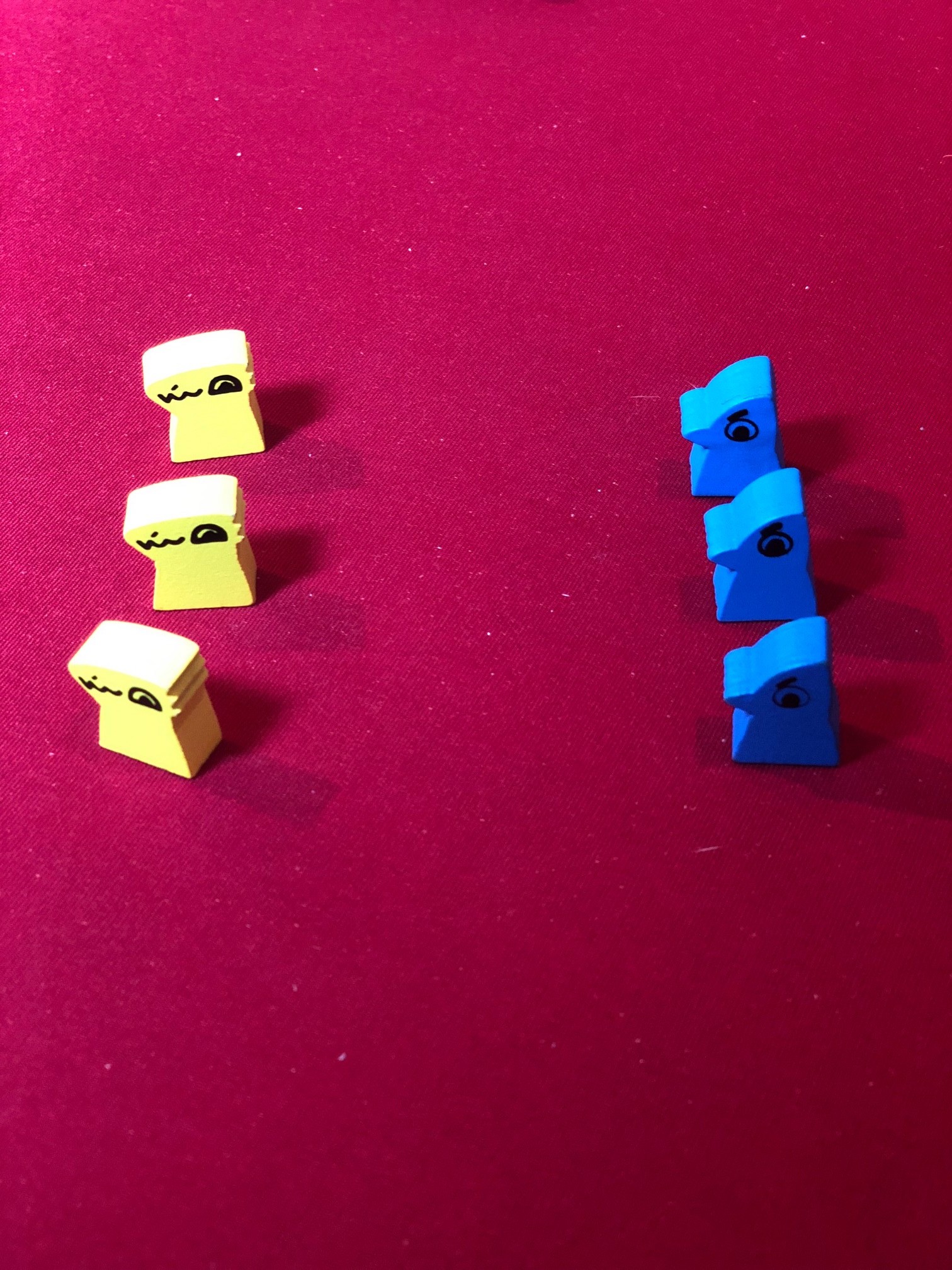
I mean, really.
An expansion faction, the Lizard Cult is what it is - a cult of lizards that desire to have the whole forest worship their dragon god. It is honestly pretty hilarious. They gain points by placing their gardens and then scoring with matching cards - easy enough, except it's fairly expensive for them to move, so instead they just kind of spawn up wherever they choose on the map through their conspiracies.
Yes, conspiracies. The Lizard Cult have Acolytes, which are effectively half-dead lizards that they can collect when attacked or by sacrificing their own on the map. Yup, it's that weird and kooky and awesome. Hijacking the discard deck as their "Lost Souls", players discard to them throughout the round, and then they spend their accumulated Acolytes on the outcast type only - the color that had the most lost souls at the start of their turn.
These conspiracies - moving and immediately battling, replacing any meeple on the map with a lizard, or even savagely replacing any building with a garden of theirs - are the core mechanic of the lizards. Add to that their gardens make them immediately rule, regardless of meeple count, and that killing their meeples gets them more Acolytes, and you've got an extremely formidable foe that will only get immensely stronger after time. Beating the lizards is a careful game of trimming the garden hedges without an all-out attack on them, while making sure they don't appear behind you and, well, convert your entire army.

dragon god? No? * stab stab *
Their Daylight phase involves them revealing - not spending - cards in their hand to take actions, or discarding cards in hand to score based on their count of gardens on the map. Herein lies the caveat with the lizards; this is really their main way of scoring, and means they have to get lots of gardens on the map to do anything. They'll lag behind in points for most of the game until they really start cranking, and when they do they'll be doing double-digit scoring per turn. However, their narrow scoring can make them easier to counter than other factions, but only if you do so proactively enough before they become a problem.
I really enjoy playing the Lizards because of their chaotic nature, and because they're just so flat-out annoying to others on the map. That's a very fun place to be in as an opponent, and you'll spend most of the game seemingly "behind" only for the rest of the table to realize these pretty gardens everywhere happen to be inhabited with chokeweed and are now taking over the game. The dragon arises!
Riverfolk Company
You have to give props to the designers for this faction - instead of adding another standard indirect, defensive, or glass cannon faction, they decided - what we need is not a group that directly competes in the conflict, but instead benefits from it - a war profiteering faction! That's exactly what Riverfolk are, and it makes them a hoot to add to larger player counts.

They spend most of their turn committing their "funds", or meeples on their board, to performing various actions. Their hand is public, simply because opponents on their turns can buy cards from them by giving meeples from their respective supplies. They'll spend those accumulated matching meeples to establish trade posts in those eager buyer's bases, which enables more trading, and throughout this whole time you can see these playful otters swimming around with their gold as the forest burns.
At the end of their turn, they set prices on things they can sell. As mentioned above, they can sell cards from their hand, or alternatively you can buy riverboats from them to be able to move across the river that spans the map. And in a genius design choice, you can actually hire the Riverfolk as mercenaries, giving you control of all their meeples on the map to use in attacking or establishing rule. It creates a supremely interesting dynamic where the Riverfolk become this wildcard that can offset leaders in the game with a few strategically spent coin.
The Riverfolk are formidable crafters, as well, and will spend a lot of time just spreading themselves around in tactical places to gain the most money. They score by placing tradeposts and crafting, and endgame will get violent to scrape enough points to pull a win. For an opponent that isn't directly aggressive, you can't ignore - or trade too much - with the Riverfolk, lest you find them owning the entire forest by the end of the game, and you becoming a peon of their war empire.
I haven't won with the Riverfolk yet, but I've come extremely close (1 point!) on a couple of plays, which tells me they will always be an interesting and competitive addition to any game.
Bonus: Solo Play

is beautifully drawn.
I do a lot of solo gaming, so when I heard that Root's Riverfolk expansion had a solo (and coop) mode, I was very interested. It introduces the Mechanical Marquise as a faction, which essentially a high-RNG, cat-spamming, aggressive class that spills paws across the board.
Essentially, the Marquis get a collection of "order" cards that will dictate where they do things throughout their turn. They'll battle in all clearing matching the card - which makes wild bird cards extremely nasty - move from matching clearings, and then recruit based on the crafting makeup of the order card. If the card has no crafting, they'll just repeat their turn again. Similarly brutal. They get points through normal battling, and also +2 at the start of their turn for every clearing they have 3+ guys in. And let me say - they will have lots of cats on the board fairly quickly.
This means a few things. One, the game goes extremely fast - solo plays for me lasted 30-45 minutes max, as the MM are just so aggressive that you have to make a hard burn toward stopping them from getting groups of threes anywhere, and everything else you wanted to do is tertiary compared to that. It quickly boils the game down to dice rolling, which kind of spoils the fun strategy of it.
I gave it a shot. It was not bad. But not good, either - how the game goes highly depends on the first few order cards that the MM draw, and how the movement plays out. Playing as the Eyrie here really is your only option, and maybe the Lizards if you get lucky. The rest of the factions simply get decimated. Honestly, though, with all the solo games I could play, I just couldn't see myself picking this one very often, since the play wasn't that fun, and there's only one faction to go against.
Double Bonus: BGG Community Solo Play

well. I mean, custom player print-outs
for solo! So great.
I was persistent, though, and wanted to give it another shot, and so off I went to the boardgamegeek.com forums, which have never failed me in the past for excellent solo
variants. And sure enough, I was not disappointed - enter the Better Bots project, done by bgg user Inconmon. He took most of the factions and created solo mechanics that allow you to drop one (or many!) into a game. Not only that, but modified the board printouts to contain the new rules, which meant I could print out the rules as new solo boards! So great. A major kudos to Inconmon for this excellent work - and still being updated as we speak!
So I took this for a spin - and it was excellent. Not only was the difficulty level strong, but there are all kinds of modifiers you can include or exclude to scale it if you choose. The AI actually plays like a real opponent, so unlike the shipped solo mode, this feels a lot more like a real game of Root. Each race is really neatly built to allow it independence, and strategically focuses on its thematic goal fairly well. I only had a few nits about the Woodland Alliance being just a bit too strong and randomly uncounterable, but overall this really heightened my solo play.
Even better is you can solo against a bunch of opponents, should you have the head space for it. The mechanics are pretty straightforward, so it doesn't take a ton of thought once you learn each automata's rules. I did a few 4-5p solo games and it was excellent; the AI don't just gang up on you, but actually end up competing against each other as well throughout the game, and nearly every 3p+ solo game I played had the AI very close in score to each other at the end.
If you're going to get Root, and play it solo, forget the shipped variant - just go here and print these off instead. It makes Root worth it for solo, instead of just an afterthought. I wouldn't say buy this game for the solo alone, even with this, but if you have it and do want to run a game by yourself, this absolutely will give you a good playthrough.
Thoughts
So, with all that in mind, how does Root play? Does it live up to the hype?

during gameplay
Let's be frank: you'll spend your first few games in a haze. Like most asymmetric games, learning all the rules and nuances can be a huge bear, and Root is no exception. Your first game will be getting a general idea on how to play your character; however, halfway through you'll start to realize you really need to be paying attention to others even more than your own. And herein lies the most interesting part of Root: unlike most games, where you're trying to optimize your play, Root nails the dynamic of what really great games do - making the interaction between players the best part.
Every game I've played of Root is so different, and interesting, and close. Not only do factions play differently, but they play differently based on what other factions are on the table, and they play wildly differently based on the play style of who is playing them. A highly aggressive, king-making Vagabond is a fun wildcard to spice up a game; but a sneaky, questing trash panda running around can come out of nowhere and snatch victory before people even notice him. Every class plays like this - and it's why getting through your first few games of Root is so important: the game pays off the more and more you invest in it.

have competition!
As you play, you'll learn the nuances between factions, and learn that it's about playing the board as much as playing the factions. Getting ahead too soon can make you a target that's tough to recover from; taking too long and being too nice can leave you with no engine at the end to sneak in a win. Games start slow in points but accelerate quickly around the 1.5 hour mark, so most games of Root I've played last around 2 hours for a 4-5 player count, which is just great for a game of this depth. Add in that the game gets faster as people learn it, and it makes it easy to get to the table.
Balancing all of this is that each faction is so uniquely powerful that no faction seems underpowered or staid. In my plays, wins have happened evenly from all the classes. Each one has a unique benefit that seems to give it an upper-hand: Eyrie's rule tiebreaker, the Marquis ability to spam the board with troops, the Alliance's amazing ability to just turn an entire game with a well-placed revolt. These feel like ace cards in your hand as those factions, and when you successfully pull one off you feel like a genius. Until the next turn when your opponent does the same, with a smug smile on his face, and you vow vengeance for your furry brethren.

Furthermore, the conflicts and tense moments throughout the game just ooze with theme: that time when the Lizard Cult, Eyrie, and Marquise are all waging a massive war in a single clearing, each positioning their troops for the great siege, each thinking that they will be the kings to rule the forest...until the oppressed Woodland Alliance revolt at the last minute to flatten the entire space and gather a massive, game-changing 14 points on the play. The tide is turned, the people have spoken, and you can feel the moment as much as experience it. It's a thrilling ride, and one that the class and socioeconomic themes of the game just resonate in a way most "dudes on a map" war games don't even come close to. As the Alliance, you'll feel like the trampled people until you're not, and then you'll be standing on your chair, singing Do You Hear the People Sing from Les Miserables as your opponents stare on from their ruined kingdoms.
You'll walk away from this game wanting to play it again, and again, and again, even after it gets old. You'll want to learn the depth of the faction you just played, even though there's others you could try, because the game leaves you feeling like you can always do just a little bit better each time.
Root will stay on my top games shelf for a long time. The entry fee for learning this game is a bit steep, but I guarantee you you'll get what you pay for: a game whose nuance, competitiveness, and subtlety will leave you always wanting to come back to the forest to wage a little more war.
Pros
* Well-crafted classes allow for deep, exciting gameplay
* Asymmetric style and interesting mechanics make for high replay value
* Excellent art and design is just stunning
* Games are always close and have nuanced table dynamics
* Theme is strong in both overall and in class play styles
* The meeples are just so great
Cons
* Asymmetric play means lots of rule-learning up front
* Some classes are punishing for new players
* Solo play is ok, need bgg community additions to make it shine
one of the best
Board game reviews and news from Austin, Texas. We provide no-nonsense reviews about all kinds of games. With flair.

